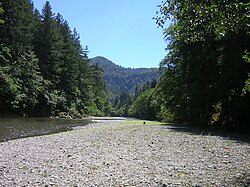
The Pomo are a Native American people of California. Historical Pomo territory in Northern California was large, bordered by the Pacific Coast to the west, extending inland to Clear Lake, mainly between Cleone and Duncans Point. One small group, the Tceefoka, lived in the vicinity of present-day Stonyford, Colusa County, were they were separated from the majority of Pomo lands by Yuki and Wintuan speakers.

Achomawi are the northerly nine bands of the Pit River tribe of Palaihnihan Native Americans who live in what is now northeastern California in the United States. These 5 autonomous bands of the Pit River Indians historically spoke slightly different dialects of one common language, and the other two bands spoke dialects of a related language, called Atsugewi. The name "Achomawi" means river people and properly applies to the band which historically inhabited the Fall River Valley and the Pit River from the south end of Big Valley Mountains, westerly to Pit River Falls. The nine bands of Achumawi lived on both sides of the Pit River from its origin at Goose Lake to Montgomery Creek, and the two bands of Atsugewi lived south of the Pit River on creeks tributary to it in the Hat Creek valley and Dixie Valley.

The Wintu are Native Americans who live in what is now Northern California. They are part of a loose association of peoples known collectively as the Wintun. There are three major groups that make up the Wintu speaking people. The Wintu, Nomlaki, and Patwin. The Wintu language is part of the Penutian language family.
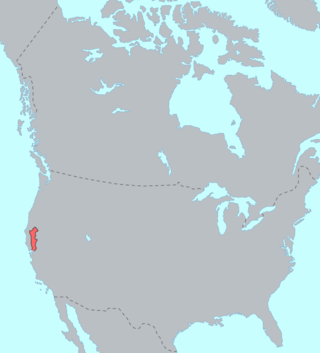
The Wintun are members of several related Native American peoples of Northern California, including the Wintu (northern), Nomlaki (central), and Patwin (southern). Their range is from approximately present-day Lake Shasta to San Francisco Bay, along the western side of the Sacramento River to the Coast Range. Each of these tribes speak one of the Wintuan languages. Linguistic and archaeological evidence suggests that the Wintun people probably entered the California area around 500 AD from what is now southern Oregon, introducing bow and arrow technology to the region. There has been carbon dating of several artifacts by UC Berkeley that dates back to around 10,000 years, and several of these artifacts have now been repatriated. Despite being a major influence on the region's history, there is still very little history on the Wintu due to centuries of genocide and displacement that still occur today along with continued destruction of sacred ceremonial and religious sites, often due to companies that ignore legal or ethical considerations.

The Maidu are a Native American people of northern California. They reside in the central Sierra Nevada, in the watershed area of the Feather and American Rivers and in Humbug Valley. In Maiduan languages, maidu means "man".
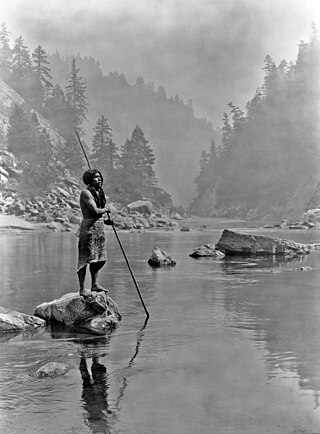
Hupa are a Native American people of the Athabaskan-speaking ethnolinguistic group in northwestern California. Their endonym is Natinixwe, also spelled Natinook-wa, meaning "People of the Place Where the Trails Return". The Karuk name was Kishákeevar / Kishakeevra. The majority of the tribe is enrolled in the federally recognized Hoopa Valley Tribe.

The Mono are a Native American people who traditionally live in the central Sierra Nevada, the Eastern Sierra, the Mono Basin, and adjacent areas of the Great Basin. They are often grouped under the historical label "Paiute" together with the Northern Paiute and Southern Paiute – but these three groups, although related within the Numic group of Uto-Aztecan languages, do not form a single, unique, unified group of Great Basin tribes.

The Cahto are an Indigenous Californian group of Native Americans. Today most descendants are enrolled as the federally recognized tribe, the Cahto Indian Tribe of the Laytonville Rancheria, and a small group of Cahto are enrolled in the Round Valley Indian Tribes of the Round Valley Reservation.

The Yokuts are an ethnic group of Native Americans native to central California. Before European contact, the Yokuts consisted of up to 60 tribes speaking several related languages. Yokuts is both plural and singular; Yokut, while common, is erroneous. 'Yokut' should only be used when referring specifically to the Tachi Yokut Tribe of Lemoore. Some of their descendants prefer to refer to themselves by their respective tribal names; they reject the term Yokuts, saying that it is an exonym invented by English-speaking settlers and historians. Conventional sub-groupings include the Foothill Yokuts, Northern Valley Yokuts, and Southern Valley Yokuts.
The Nomlaki are a Wintun people native to the area of the Sacramento Valley, extending westward to the Coast Range in Northern California. Today some Nomlaki people are enrolled in the federally recognized tribes: Round Valley Indian Tribes, Grindstone Indian Rancheria or the Paskenta Band of Nomlaki Indians. The Nomlaki were bordered by the Wintu (Wintun) in the north, the Yana in the northeast and east, the Konkow (Maiduan) in the east, the Patwin (Wintun) in the south, and the Yuki in the west.

The Patwin are a band of Wintun people in Northern California. The Patwin comprise the southern branch of the Wintun group, native inhabitants of California since approximately 500.
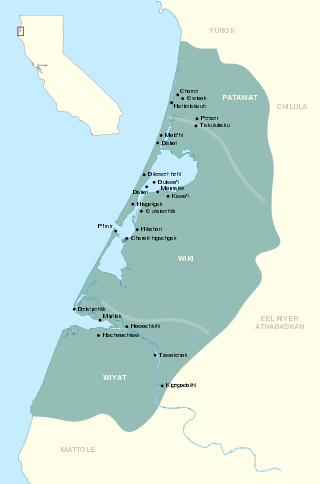
The Wiyot are an indigenous people of California living near Humboldt Bay, California and a small surrounding area. They are culturally similar to the Yurok people. They called themselves simply Ku'wil, meaning "the People". Today, there are approximately 450 Wiyot people. They are enrolled in several federally recognized tribes, such as the Wiyot Tribe, Bear River Band of the Rohnerville Rancheria, Blue Lake Rancheria, and the Cher-Ae Heights Indian Community of the Trinidad Rancheria.

The Round Valley Indian Reservation is a federally recognized Indian reservation lying primarily in northern Mendocino County, California, United States. A small part of it extends northward into southern Trinity County. The total land area, including off-reservation trust land, is 93.939 km2. More than two-thirds of this area is off-reservation trust land, including about 405 acres (1.64 km2) in the community of Covelo. The total resident population as of the 2000 census was 300 persons, of whom 99 lived in Covelo.
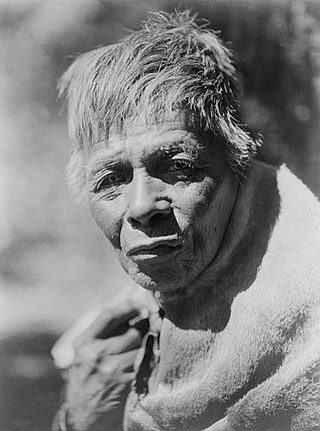
The Eel River Athapaskans include the Wailaki, Lassik, Nongatl, and Sinkyone (Sinkine) groups of Native Americans that traditionally live in present-day Mendocino, Trinity, and Humboldt counties on or near the Eel River and Van Duzen River of northwestern California.
The Tolowa people or Taa-laa-wa Dee-ni’ are a Native American people of the Athabaskan-speaking ethno-linguistic group. Two rancherías still reside in their traditional territory in northwestern California. Those removed to the Siletz Reservation in Oregon are located there.
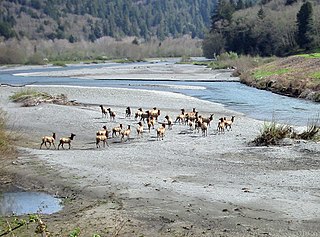
The Whilkut also known as "(Upper) Redwood Creek Indians" or "Mad River Indians" were a Pacific Coast Athabaskan tribe speaking a dialect similar to the Hupa to the northeast and Chilula to the north, who inhabited the area on or near the Upper Redwood Creek and along the Mad River except near its mouth, up to Iaqua Butte, and some settlement in Grouse Creek in the Trinity River drainage in Northwestern California, before contact with Europeans.

The Yana are a group of Native Americans indigenous to Northern California in the central Sierra Nevada, on the western side of the range. Their lands, prior to encroachment by white settlers, bordered the Pit and Feather rivers. They were nearly destroyed during the California genocide in the latter half of the 19th century. The Central and Southern Yana continue to live in California as members of Redding Rancheria.

The Bear River Band of the Rohnerville Rancheria is a federally recognized tribe of Mattole, Bear River and Wiyot people in Humboldt County, California.
The Grindstone Indian Rancheria of Wintun-Wailaki Indians is a federally recognized tribe and ranchería of Wintun and Wailaki Indians from northern California. As of the 2010 Census the population was 164.
The Wiyot Tribe, California is a federally recognized tribe of Wiyot people. They are the aboriginal people of Humboldt Bay, Mad River and lower Eel River of California.
